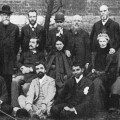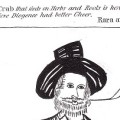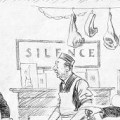THE COUNTRY HOME – front cover of the issue from – SEPTEMBER 1935
There is a somewhat bizarre ‘vegetarian’ article on p42 – see below.
3D vegetable art by Carl V. Burger (1888-1967) – an artist and writer of children’s books about animals and natural history.
Wiki – Archive – More of Carl’s work – Pinterest
A fun item in our Ernest Bell Library collection.
Above are images of the front cover & of Burger’s article on p42.
Some very ‘different’ vegetable art – vegetable carving – from almost 80 years ago.
.
The article transcribed for easier reading.
THE VEGETARIAN’S BARNYARD
by CARL BURGER
THE irresponsible barnyard animals pictured on this month’s cover are very adaptable pets. They’Il gladly stay in their own neat barnyard. They’ll decorate your exhibit at the fair or harvest show. They’ll form an amusing centerpiece or place cards on a party table and mightily entertain all comers. And they’ll even relieve you of quite a bit of responsibility as host or hostess if you supply your guests with a pile of scrubbed vegetables and award a suitably silly prize for the greatest barnyard wonder evolved.
A careful look at the picture will disclose some secrets of animal husbandry. The wild-eyed colts, for instance, are made of potatoes-sweet for the body, white for the head, with toothpicks to hold the various sections together. Unseen pins hold in the peas which are their eyes, the onion roots which are their flowing manes and tails, the snips of pea pods which are their ears.
The mama cow plainly owes her origin to eggplant and green pepper. Her offspring (a turnip head, potato body and scallion legs) is paying strict attention to a plump red onion. Perched on the pink rhubarb fence is an elegant rooster, made, like his brethren on the ground, from a pert radish, a tiny carrot for a head, Lima bean pods for wings. He flaunts a comb of red onion skin and a magnificent tail of tender rhubarb tops. The young ducks in the lower left corner are also radishes; standing on carrot feet and having peanuts for heads. Watercolor paint is responsible for their mischievous expressions.
So much for the barnyard animals on the cover. Now for the circus parade beginning at our left above with of all things, a squash dragon. Lima bean pods make his short legs and the ferocious hackles on his back. A fiery red pepper is his awful face. The fearless bird beside him is a white radish, boasting okra for head and wings. The tiny bird next in order is another member of the radish family. The flighty fowl left above the elephant has all the strength an onion body can give him. Two slim carrots make his head and neck, and onion tops are to blame for his tail feathers.
Wabbling along on twigs to the right is the leggy stork. He rejoices in a sweet potato body, carroty neck and head, with red cabbage for wings and rhubarb tips for tail. The docile elephant with downcast eyes combines a turnip, double headed parsnip, carrots, red cabbage leaf, and wax beans for tusks.
I hope you have as much fun with these animals as I have had.
…………………………………………………………………………………………………………….
…………………………………………………………………………………………………………….
Some notes on Wheeler McMillan & wars & bankers & chemurgy
The editor of this short-lived magazine THE COUNTRY HOME was Wheeler McMillan (1893-1992) – brief bio
A famous Wheeler McMillan quotation –
~ The seeds of the depression of the nineteen thirties were planted in the war years of 1914-18. They sprouted in August, 1921. That was when country banks were ordered by the Federal Reserve Board not to renew their notes from ranchmen and farmers but to collect them, in full and at once. ~ – Wheeler McMillan – 1950 – in his book – New Riches from the Soil.
FEDERAL RESERVE BULLETIN AUGUST 1921 – see page 897 for their denials about cotton notes!
World War I had created an atmosphere of high prices for agricultural products as European nations demand for exports surged. Farmers had enjoyed a period of prosperity as U.S. farm production expanded rapidly to fill the gap left as European belligerents found themselves unable to produce enough food. When the war ended, supply increased rapidly as Europe’s agricultural market rebounded. Overproduction led to plummeting prices which led to stagnant market conditions and living standards for farmers in the 1920s. Worse, hundreds of thousands of farmers had taken out mortgages and loans to buy out their neighbors’ property, and now are unable to meet the financial burden. The cause was the collapse of land prices after the wartime bubble when farmers used high prices to buy up neighboring farms at high prices, saddling them with heavy debts. Farmers, however, blamed the decline of foreign markets, and the effects of the protective tariff. – wiki
NINE DECADES IN THE HUMAN RACE By Wheeler McMillen –
Click here – to read the entire unpublished book.
For just the chapter reflecting on THE COUNTRY HOME magazine – click here.
McMillen’s unpublished book NINE DECADES IN THE HUMAN RACE is in no way veg(etari)an.
It does give some very interesting insights into pre-WW2 farming in the US.
Excerpt – 1921 –
Another great new area for more education was presenting itself. I didn’t realize that the Federal Reserve Board in Washington, alarmed at postwar inflation, perhaps not aware as to how far-reaching the effects of its powers might be, had taken steps for the contraction of credit. Over-extended ranchmen two thousand miles from Ohio had been compelled to sacrifice herds to meet their bank obligations. Midwest farmers had had to put animals on the market to pay off the ninety-day notes that normally the banks would have renewed. The price of beef crashed and prices of hogs went down. The generous returns of my August calculations were cut in half.
During the first summer on the farm, the summer of 1918, I had found hours to tramp the forty acres of pasture that lay along the north side of the place. The dozen acres nearest to the barn were adequate for the milk cows and horses. I proposed that we fence off the larger end, clear out the stumps and remaining trees, and add another sizeable cultivated field to the farm. “It will produce enough,” I argued, “to hire a man. Then I can give better attention to the hogs and have a little more free time.”
Father and I were operating under the usual “fifty-fifty” landlord-tenant arrangements. He furnished the land, paid the taxes, bought half the seed and fertilizer, paid half the threshing bill, maintained the buildings and fences. I
furnished the equipment and labor. We divided the proceeds of all sales half and half. I saw that our volume of sales had to be increased before I could afford a full-time hired man. Without such a man I was certain to be tied continuously to the farm routine. The agreement was not only customary but in this case more than fair because Father contributed his own labor nearly every day. He preferred work to idleness. That fall, for the first time since Father had owned it, corn was sold off the farm. It had been his policy to sell no crop except wheat; everything else left the place wrapped in the hides of livestock. This time, with the twenty-seven new acres, we had more corn than we could expect to feed, and corn was in great demand. Buyers gladly came for it and paid $1.80 a bushel. “Son, you will never see $1.80 corn again,” Father said. “That’s a big price. We can afford to sell some.” He was right for more than two decades ahead until war and inflation returned.
He was right about most things, and we seldom failed to come to easy agreement on the farm operations. His generous willingness to let me take the lead in an occasional new venture made our relationship a pleasant and happy one. He was willing to let me make a mistake occasionally, expecting that I would learn faster that way.
Nowadays Wheeler McMillan is perhaps best remembered for his involvement in the promotion of –
Chemurgy – a noun – meaning ‘the development of new industrial chemical products from organic raw materials, especially from those of agricultural origin.’
Chemurgy is a branch of applied chemistry that is concerned with preparing industrial products from agricultural raw materials. The word “chemurgy” was coined by chemist William J. Hale and first publicized in his 1934 book The Farm Chemurgic, the concept was mildly well-developed by the early years of the 20th century. For example, a number of products, including brushes and motion picture film, were made from cellulose. Beginning in the 1920s, some prominent Americans began to advocate a more widespread link between farmers and industry. Among them were William J. Hale and agricultural journalist Wheeler McMillen. – Wiki
…………………………………………………………………………………………………………….
The Ernest Bell Library is actively building a collection of examples of marketing activities related to: –
- veg(etari)an products.
- veg(etari)an books & other publications.
- veg(etari)an organisations.
- veg(etari)an businesses.
- animal rights organisations.
- animal rights publications.
- humanitarian organisations.
- humanitarian publications.
- rambling clubs run by members of the above groups & related publications.
We also have a fine & growing collection of –
~ art created by humans – primarily for the benefit of animals ~
– both original artwork & printed / manufactured items.
If anyone would like to help by either Adopting or Sponsoring items in the library, please be in touch.
We are working seriously on cataloging the collection, as & when funds are available.
…………………………………………………………………………………………………………….
If anyone would like a high res. scan of either of these images – just send an email to: –
humanitarianleague (at) outlook (dot) com
– or message me through HappyCow –
https://www.happycow.net/blog/author/JohnnySensible/








No Comments